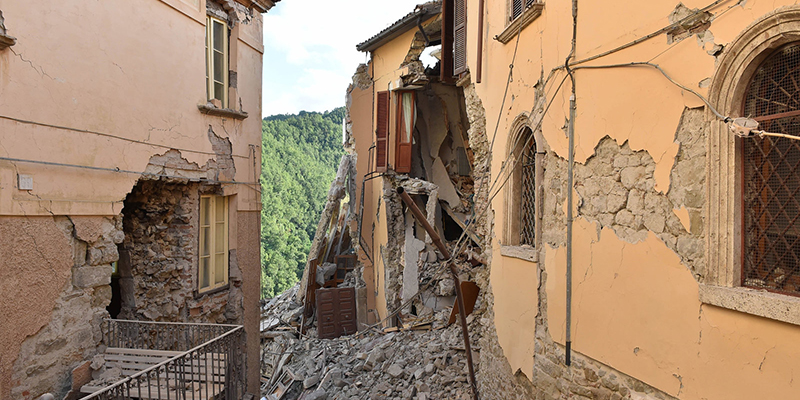
 |
| After earthquake, Italians ask tough questions about building codes. |
SHARE    |
 |
| One of the towns at the epicenter of the quake — Arquata del Tronto — is a scene of devastation, with thousands of people left homeless. Most of the charming three-story buildings and houses in the area — unreinforced brick or concrete frame buildings — were vulnerable to earthquakes, according to the U.S. Geological Survey. Photo: Getty Images |
| Italy is one of the most seismically active countries in Europe, and is no stranger to deadly earthquakes.
At least 290 people were killed after a 6.2-magnitude earthquake struck central Italy on Aug. 24, according to Italy's Civil Protection Department. The earthquake, estimated to have struck shortly after 3.30 a.m. at a shallow depth of 10km below the epicenter, was felt across a vast region of the country, including the capital Rome. A series of aftershocks have continued to affect the area, including a second earthquake of magnitude 5.5. The towns at the epicenter of the quake — Amatrice, Accumoli and Arquata del Tronto — are scenes of devastation, with thousands of people left homeless. Most of the charming three-story buildings and houses in the area — unreinforced brick or concrete frame buildings — were vulnerable to earthquakes, according to the U.S. Geological Survey, and offered little resistance. While there is currently no way of predicting an earthquake, the best way to minimize the impact is to ensure all buildings in tremor-prone areas are correctly reinforced, and attention is turning to whether a culture of impunity toward building codes contributed to the high number of casualties. In the early 20th century, thousands of people were killed in Italy's numerous earthquakes; in the latter half of the 20th century, the death toll in earthquakes started to decrease, in correlation to Italy advancing its building codes with a mind towards the quakes. Seismologist Leonardo Seeber, a research professor at the Lamont-Doherty Earth Observatory at Columbia University, was born in Florence and has studied the tectonic activity of the Apennine region for more than 35 years. "Italy is an old country, and the houses are made of stone," he said. "Just as important as what the earth does, is what humans build on top of it. Closely packed medieval buildings, constructed before the emergence of things such as building codes and reinforced concrete, are vulnerable to shaking and much more dangerous when they collapse." "Although Italian seismic building codes are state-of-the-art, they are applied to new buildings and the majority of the building stock precedes the introduction of these seismic codes." Italy's advances in construction and building codes have resulted in modern structures that are better able to withstand the impact of earthquakes. However, in many of Italy's historic towns and villages, it's not possible to protect centuries-old buildings and their heritage. "Why the earthquakes cause so many casualties is linked to the vulnerability of the building stock," stated Dr. Tiziana Rossetto, a professor of earthquake engineering at University College London. "Although Italian seismic building codes are state-of-the-art, they are applied to new buildings and the majority of the building stock precedes the introduction of these seismic codes." "In particular, the historical centers of many small towns, such as in the affected areas, are composed of fairly weak masonry construction that is very vulnerable to earthquakes, in particular if no strengthening interventions have been carried out in the past," Rossetto continued. "This means that moderate earthquakes can result in the collapse of buildings, and therefore, casualties." In a country littered with illegal buildings and construction eyesores, Italian experts blame the use of low-quality cement and inadequate supporting iron rods, saying tens of thousands of palaces, schools and hospitals are at risk. Gian Michele Calvi, chairman of the European center for research in earthquake engineering, said that 80,000 public buildings in Italy were still unsafe despite the enforcement of construction regulations after previous natural disasters; of these 22,000 were schools in seismic areas, and out of another 16,000 buildings in zones considered at risk, 9,000 were not built with modern anti-seismic criteria. Read more at the CS Monitor >> |